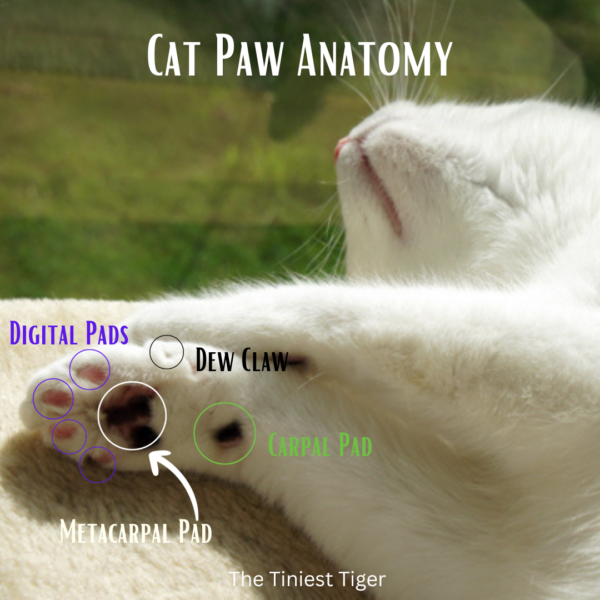
Cat Paw Anatomy: A Cat Parent Guide
Cat paw anatomy is fascinating and complex, with various structures and features designed to help our feline friends navigate their environment with grace and agility. Understanding the intricate details of cat paws not only allows us to better appreciate these remarkable creatures but can also assist in detecting potential health issues that may impact their well-being.
Paw pads, composed of tough and resilient tissue, serve as a protective layer for the underlying bones and joints, allowing cats to comfortably walk on a variety of surfaces. Feline paws also house retractable claws, which are crucial for climbing, hunting, and self-defense. Retractable claws help keep them sharp since they don’t continually contact the ground, further highlighting the adaptive nature of cat paw anatomy. Additionally, knowing the basic features of a cat’s paw can help pet owners identify common health issues like nail overgrowth, infections, or injury.
Key Takeaways
- Cat paw anatomy is an intricate system with various features designed for agility and survival.
- An understanding of cat paws’ structure can help detect potential health problems and improve overall care.
- Retractable claws and paw pads are essential components that enable cats to adapt to their environment effectively.
Understanding Cat Paw Anatomy
Cat paw anatomy is an essential aspect of their overall physical structure and function. The complex design of a cat’s paw is comprised of bones, joints, muscles, skin, claws, and paw pads, all working together to provide the cat with its unique capabilities in agility and dexterity.
The cat’s paw is comprised of several small bones that form the digits or toes. Each toe consists of three individual bones, the first two being relatively long and thin, while the third one is shorter and more curved. Cats walk on their toes, a characteristic known as being digitigrade, which provides them with increased flexibility, speed, and silence when moving.
Joints connect the bones and enable the cat’s paw flexibility. They allow the paw to bend and move in various directions, contributing to their exceptional ability to climb, jump, and walk with precision. The muscles work in sync with the joints to create smooth and powerful movements. The cat’s paw muscles also assist in retracting and extending their claws, a vital skill for hunting and self-defense.
The skin on a cat’s paw plays a crucial role in protecting the inner structures. It covers the entire paw, forming a barrier against external threats like sharp objects and environmental hazards. The skin also contains numerous receptors that provide the cat with sensory information, allowing them to detect changes in pressure, temperature, and texture.
The cat’s claw anatomy is critical for their survival. Claws grow continuously, with a cornified outer layer that sheds periodically to reveal a new, sharper claw underneath. This process ensures that their claws remain sharp for hunting, climbing, and self-defense purposes. Additionally, cats have a unique ability to retract their claws, preventing unnecessary wear and noise when walking on different surfaces.
A distinguishing feature in cat paw anatomy is the cat paw pad, composed of a thick layer of fatty tissue, collagen, and elastin. These pads provide cushioning and support when walking, prevent slippage on slippery surfaces, and act as shock absorbers during high-impact activities. Moreover, the paw pads are designed to withstand different temperatures, protecting the cat against hot and cold surfaces.

Features of Cat Paw anatomy
Front Paws
Cats rely on their front paws for various tasks. These paws consist of carpal bones, which enable the wrist’s movement, and the metacarpal pad that aids in balance and weight support. Front paws are mostly used for gripping and manipulating objects. Cats also use the front paws when hunting to trap and immobilize prey.
Back Paws
The back paws of a cat are essential for maintaining balance, stability, and jumping power. They contain tarsal bones, which are analogous to the carpal bones of the front paws, and the metatarsal pad that provides balance and weight support. The strong muscles in the back legs allow for powerful jumps and agile movement.
Paw Pads
Cat paw pads are specialized structures that serve many functions such as providing traction, serving as shock absorbers, and aiding in sensing temperature and texture. The color of the paw pads varies, and they consist of sweat glands that help maintain temperature regulation. The paw pads are made of digital pads that offer cushioning during movement, in conjunction with the metacarpal and metatarsal pads.
Claws
Cat claws are essential for hunting, self-defense, and scratching. They are made of keratin, similar to human nails, and are retractable, which helps prevent damage and maintain sharpness. Cats can extend or retract their claws using the muscles and tendons in their paws. The extra claw on the front paw is called the dewclaw.
Polydactyl Paws
Polydactyl paws in cats refer to the presence of extra toes due to a genetic mutation resulting in polydactyly. While this unusual trait doesn’t usually affect the cat’s health, it can give these felines a unique appearance. Most cats have 18 toes- five on each front leg and four on each hind leg.
Communication and Cat Paws
Cats communicate with other animals and humans through body language, vocalizations, and scent markings. They use their paws to spread their pheromones from the scent glands located on their paw pads. This process helps to communicate territorial boundaries or to signal friendliness to other cats.
Cat Paws and Hunting
Cats are natural predators, and their paws play a significant role in hunting. The paw pad’s cushioning and shock absorption help cats to maintain traction, speed, and stealth; this is especially important when stalking prey. In the hunt, their retractable claws further assist in catching and securing prey.
Cat Paws for Grooming
Grooming is essential for cats to maintain their fur’s cleanliness and reduce shedding. They often use their paws, along with their tongue, which contains papillae, to groom themselves. By licking their paws and running them over their fur, cats can effectively remove dirt, debris, and loose hair.

Common Health Issues with Cat Paws
Veterinary Care
Regular visits to a veterinarian are essential in maintaining your cat’s overall health, including their paws. They can examine the paw pad anatomy, including dewclaws, blood vessels, and nerves, ensuring everything is in good condition.
Notable Issues
Some common problems include infections, inflammation, and injuries—particularly to the dew claw, which can easily catch on things and become damaged. Swollen or tender paws can signal an issue warranting veterinary attention.
Paw Pad Injuries
Paw pad injuries can result from various factors, such as walking on hot pavement, rough surfaces, or sharp objects. Burns or cuts on the pads make it painful for the cat to walk, and they may require treatment to avoid infection.
Genetic Conditions
Certain breeds, such as Maine Coon and other domestic cats, may exhibit a genetic condition called polydactylism, which is having extra toes on their paws. While not generally harmful, polydactyl cats may require additional care or grooming to ensure their extra toes stay healthy.
Caring for Cat Paws
Proper care of cat paws includes regular grooming and checking for signs of injury or infection. Scratching is a natural behavior for cats and providing them with appropriate surfaces to scratch can help maintain their claws’ health.
Cats and Their Unique Anatomy
Cats’ unique paw anatomy ensures their comfort and mobility across various surfaces. The paw pads provide protection to blood vessels and nerves while offering cushioning support.
Frequently Asked Questions about Cat paw anatomy
What is the structure of a cat’s paw pads?
A cat’s paw pad is made up of thick, tough skin and fatty tissue that provides cushioning and protection. Within the pad, there are sweat glands and nerve endings, which help the cat maintain grip and detect changes in their environment.
The pad is divided into smaller sections called digital pads, which correspond to each toe, and a larger central pad called the metacarpal pad. In some cases, cats may have fewer arteriovenous anastomoses (AVAs) in their paw pads compared to dogs, implying a lesser role in thermoregulation.
Where Do Cats Sweat From?
Cats sweat through their paw pads, which contain sweat glands and nerve endings. These sweat glands play a crucial role in helping cats maintain grip and detect changes in their environment. While the paw pads may not have a significant surface area to effectively regulate a cat’s body temperature, they serve as the primary location for sweat release in feline anatomy. This means that when a cat becomes nervous, it can leave little sweaty paw prints on surfaces like an exam table, showcasing their unique way of reacting to stressful situations. So, if you’ve ever wondered where cats sweat from, look no further than their paw pads, where sweat glands and nerve endings work together to assist them in both gripping surfaces and sensing their surroundings.
How effective are the sweat glands in a cat’s paw pads in controlling their body temperature?
The paw pads don’t have enough surface area to do much in the way of controlling a cat’s body temperature.
What is the purpose of the sweat glands in a cat’s paw pads?
The sweat glands within the paw pads help the cat maintain grip and detect changes in their environment.
Can a cat’s sweating through their paw pads leave any noticeable traces?
Yes, a nervous cat can leave little sweaty pawprints on surfaces like an exam table at the vet’s office.
Do cats have sweat glands in any other part of their body?
No, the paw pads are the only part of a cat’s body that has sweat glands.
Where do cats sweat from?
Cats sweat through their paw pads.
What are the key differences between front and hind paws in cats?
Front paws in cats typically have five toes, while hind paws have four. The front paws are more dexterous and better equipped for gripping and manipulating objects, while the hind paws are primarily responsible for propulsion and balance during movement. Cats’ front and hind paws are adapted to their natural climbing and leaping abilities, providing them with increased agility.
How does a polydactyl cat’s paw differ from a normal cat’s paw?
A polydactyl cat’s paw is characterized by having extra toes, beyond the usual four on the hind paws and five on the front paws. This genetic mutation is caused by a dominant gene and can result in one or more additional toes on each paw. These extra toes can sometimes give the cat an enhanced ability to grip and manipulate objects.
What is the purpose of the extra pad on a cat’s hind paw?
The additional pad found on a cat’s hind paw is called the carpal pad. It is located above the metacarpal pad and acts as a shock absorber when the cat jumps down from heights. The carpal pad aids in maintaining balance and traction during movement and also plays a role in protecting the joint when a cat flexes its paw.
How do cat paws adapt to their environment?
Cat paws are highly adaptable to different environments. They can expand and contract in response to temperature changes or terrain, ensuring adequate surface contact and traction. Cats living in colder climates may develop thicker paw pads for added insulation, while those in hotter regions might have thinner pads to dissipate heat more effectively. Cats also possess retractable claws that help them to grip surfaces when climbing or catch their prey.
What are the common issues that can arise within a cat’s paw?
Common issues that can affect a cat’s paw include cuts, scrapes, and bruising caused by stepping on sharp objects or rough surfaces. Infections, parasites, and allergies can lead to irritations, inflammation, or swelling. Overgrown claws can curve inwards and cause discomfort, or even puncture the paw pad. In such cases, it’s essential to promptly consult a veterinarian to assess the problem and determine the appropriate course of action.